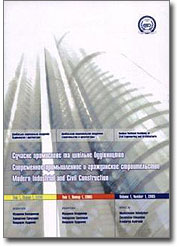Experimental Studies of Mechanical Properties of Hardening Cement-Sand Mortar with Different Water-Cement Ratio under Temperature Gradient
Abstract: The article presents the results of a study of the strength characteristics of a rod made of a cement-sand mixture with a certain ratio of water and cement (V/C = 0.4; 0.44; 0.49 and 0.54), which hardens under temperature gradients. The purpose of this study is an experimental study of the effect of temperature gradients on the mechanical properties of a hardened cement-sand mortar with a changing ratio of water and cement. The study showed that the increase in the strength of cement-sand cube samples varies in intensity during different periods of solidification and testing. It was found that temperature gradients (+60... (–20)) oC have a significant effect on the solidification of cement-sand samples-cubes. After 8 hours of hardening, there is a tendency to increase the accumulation of strength, starting with the 5th sample. It can be expected that with further hardening time, the tendency to non-monotonic hardening will be more pronounced. The study of these processes will help to better understand the degree of negative impact of temperature changes on concrete structures and subsequently develop measures to increase their service life.
Keywords: temperaturegradient, cementstone, masstrans.
Pages: 71-78.
For citation:
For citation: Pyankova, K. A.; Vcherashniy, D. D.; Korobkov, S. V. Experimental Studies of Mechanical Properties of Hardening Cement-Sand Mortar with Different Water-Cement Ratio under Temperature Gradient. – Text : electronic. – In: <em>Modern Industrial and Civil Construction</em>. – 2023. – Vol. 19, N 2. – Р. 71-78. – URL: https://donnasa.ru/publish_house/journals/spgs/2023-2/st_04_pyankova_vcherashniy_korobkov.pdf (date of access: 22.12.2024). – ISSN 1993-3495.

Vol. 19, N 2 (2023)
Journal: Modern Industrial and Civil Construction
Publish house: Donbas National Academy of Civil Engineering and Architecture
Journal: Modern Industrial and Civil Construction
Publish house: Donbas National Academy of Civil Engineering and Architecture
